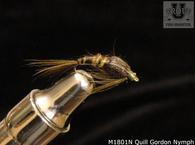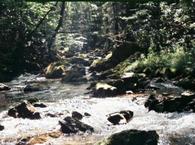
Nymph General Description:
The Quill Gordon nymphs are flat shaped and have two tails. They are clingers preferring to remain attached to the bottom gravel and stones of the stream making it somewhat difficult for the trout to eat them. Should they become unattached they will tumble down the stream in an awkward fashion, but this seldom happens.
Before emerging, they will crawl on the bottom to the slower waters, which may or may not be shallower water, but often will be behind a large rock or near a bank. Remember they don't necessarily move to shallow water, just slower calmer water and most of the time this means they move behind a boulder or large rock to hatch. They will congregate in these small pockets of calmer water within the faster portions of the water. Once in the slower water, the Quill Gordon nymph will commence to hatch.
Remember the important difference from other mayflies is that the Quill Gordons hatch on the bottom or on their accent to the surface while other mayflies hatch on the surface film. As they rise to the surface the wings will open so wet flies like the wet dun will work great during the hatch. As they leave the bottom, they will shed their shucks.
Nymph Presentation:
The Quill Gordon nymphs must be weighted properly to fish the faster moving water and seek the bottom where the nymphs live. The nymphs will begin to emerge in the early cool mornings and early afternoons, so you should fish them at that time in the current seems where the water is downstream from the calmer waters. After the hatch begins, the trout begin to feed on the emerging nymphs and that will signal the need to switch to the wet or even the dry imitations of the du n
n
 n
nSee the new double sided fly boxes
Bait/Lure Type:
Equipment:





